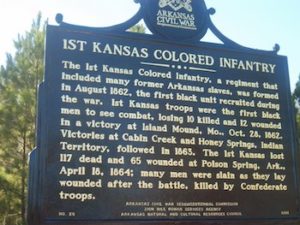
*On this date, in 1862, the 1st Kansas Volunteer Colored Infantry was formed. This was the first official regiment of Blacks serving in the American Army.
Captain James M. Williams, Co. F, 5th Kansas Cavalry, was appointed for that portion of Kansas. The area where Kansas Volunteer Colored Infantry was organized was north of the Kansas River. Captain Williams enlisted Captain H.C. Seaman and other 2nd Lieutenant recruiting officers and obtained supplies from departments near Leavenworth.
500 men were recruited within sixty days, and the battalion was mustered into the U.S. service. This request was not complied with, and the reasons assigned were wholly unsatisfactory, yet accompanied with assurances of such a nature as to warrant the belief that a short time would elapse before the request would be complied with.
Problems with the civil authorities in the Northern District threatened their beginning. They were: 1. Rebellion. 2. Prejudices against Blacks. 3. Loyalists believed that the War Department would not approve enlisting black men. 4. Many believed that the Negro was not qualified to make efficient soldiers. The result would be defeat, disaster, and disgrace.
Col. Williams followed his instructions to the letter. On October 28, 1862, a command of detachments was moved and camped at Wilson’s Creek near Butler. About 225 men, under Capt. Seaman was attacked by a rebel force of about 500 and was defeated. The Union loss was ten killed and 12 wounded. The next morning they were reinforced by a few recruits and chased, though they never caught the enemy.
This battle was to be the first in the American Civil War where colored troops were used. Signing up continued until January 1863, when a battalion of six companies was mustered into the U.S. In May 1863, the other four companies were organized. The regiment was eventually ordered to Baxter Springs.
Civil War on the Western Border.org
Report of the Adjutant General of the State of Kansas,
1861-’65.
Topeka, Kansas: 1896 reprint.
by Dale Vaughn, Civil War Roundtable of Eastern Kansas